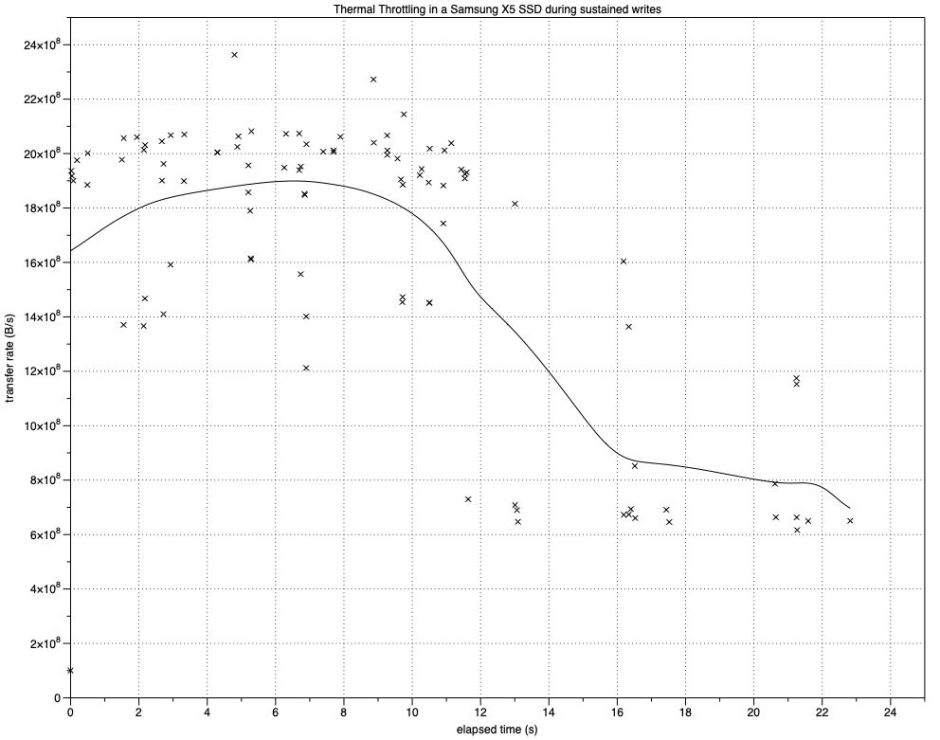One of the best-known tales from classical mythology, of Pandora and her box containing all the world’s evils, is both incorrect and a modern confuddling of two different myths. Pandora’s container was originally a jar rather than a box, an error attributed to Erasmus, and became muddled with a myth about Psyche in the early nineteenth century, when the story suddenly became popular in paintings. This is only appropriate for the topic which last week consumed more time and words than any other here, Pandora’s peripherals, external SSDs.
It all started with some worrying benchmarks reported by a user, who suggested there was a problem with M1 Macs leading to poor performance of external SSDs connected via USB rather than Thunderbolt. I then undertook a little experiment in which I measured transfer speeds for the same drive connected to different Macs and ports. Although some claimed this was all just clickbait, it has generated more interest and comments than almost any other topic here, and so far no one has been able to explain away the consistent differences I reported. Neither has anyone else come up with an explanation as to why so many others are seeing similarly poor performance from their M1 Macs.
Most of us don’t choose to use external SSDs, except for storage for our backups and large collections of more static files like media libraries. In my case, it was an error that I made when specifying this iMac Pro. Wincing more than a little at the cost of the base model with 1 TB internal SSD, I decided that I’d spread much of my existing 1.4 TB from my previous iMac’s Fusion Drive onto external storage, at the time when I was moving away from hard disks. A 2 TB SATA/USB-C (USB 3.1 Gen 2) SSD was considerably cheaper than the additional cost of 2 TB of internal storage, and almost kept the cost of the iMac Pro below £5,000. It’s a mistake I’ll not make again, and the Mac Studio Max which will replace that iMac Pro has 2 TB inside it.
The files on my external SSD aren’t particularly large or demanding, and I’ve been quite content with transfer speeds around 470-480 MB/s. I did buy a Samsung X5 512 GB in the hope that moving up to Thunderbolt speed would be worth the extra cost. But when I looked at its write performance, I realised how quickly it suffered from thermal throttling, as demonstrated in the chart below.

This test, which I ran over a year ago on that X5, consisted of writing a series of 96 files ranging in size from 2 MB to 2 GB, and the chart shows transfer rates for each file against time since the start of the test. During the first 11.6 seconds of writing, speed remained fairly steady at about 2 GB/s, with the lowest at 1.2 GB/s. Suddenly, after 11.6 seconds had elapsed, rates fell to around 670 MB/s, following which only five writes exceeded 1 GB/s. The cumulative amount of data that had been written to the SSD at the time that it underwent thermal throttling was only 24 GB. I realised that paying the premium for a high-speed external SSD would end in remorse every time I tried to write anything chunky to it.
Try writing 320 test files totalling just over 100 GB in 20 seconds to the internal SSD of a Mac Studio, though, and it maintains a transfer rate of more than 7 GB/s, with no evidence of thermal throttling. Read rates of more than 6.5 GB/s can also be sustained comfortably for 2.1 TB over a little more than 6 minutes.
In addition to a library of seven SATA/USB-C (USB 3.1 Gen 2) SSDs ranging in size from 750 GB to 2 TB, I invested in a splendid OWC ThunderBay 4 enclosure which is currently populated with four 2 TB SATA SSDs, containing backups and static storage, as a replacement for my ancient Promise Pegasus four-bay hard disk RAID enclosure. I had originally intended to configure those SSDs as a RAID, but admitted defeat when I couldn’t get the software to keep pace with macOS security and updates. Along with my other Thunderbolt devices, it confirmed how much simpler and more reliable certified Thunderbolt products are than Pandora’s peripherals with USB.
Next week I start a new quest, this time assessing the performance of Thunderbolt 3 external SSDs with M1 Macs, to see whether the far less frequent reports of poor performance are another of the ills released by Pandora. This time, I’m limiting most of my tests to read, so as to avoid encountering thermal throttling, which I’m going to assess separately. For this I’m yet again taking the lid off Pandora’s jar, and looking for some hope inside it.
